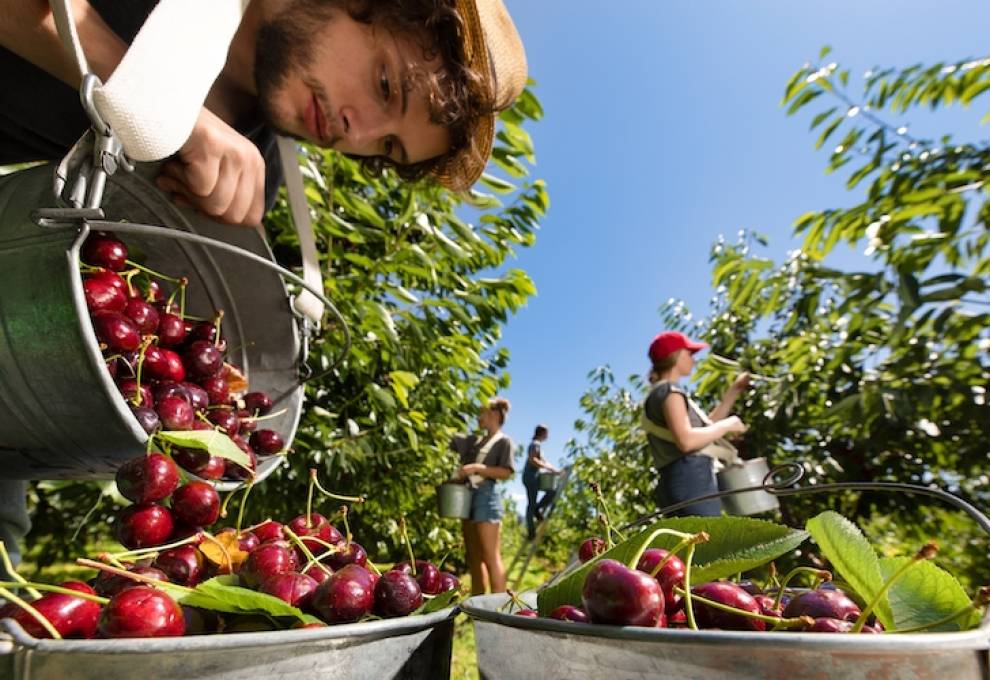
Staccato is an intriguing name for a sweet cherry. From a musician’s perspective, ‘staccato’ means to sting the note in a jumpy precise rhythm. But from a grower’s perspective, it defines a bounce in sales.
Increased domestic sales are exactly what the BC Cherry Association is hoping with the inaugural launch of Canadian Cherry Month, July 15-August 15, 2023. While the association’s international reputation for Okanagan and Creston Valley cherries is well earned from the UK and Europe to China, Japan and most recently, South Korea, there’s room to raise awareness outside of British Columbia.
As 2023 production crests 5,500 acres, the risks of being too focussed on overseas markets were laid bare when global logistics were disrupted during the pandemic. BC cherries are the envy of the world so it’s only natural they should take pride of place in Canada as well. Raising domestic awareness is but a logical step for the BC Cherry Association.
“We’re aware that premium cherries will be needed in the eastern market,” says Suhkpaul Bal, chair of the BC Cherry Association based in Kelowna. “We know this is a market accustomed to Washington State cherries.”
As a grower of 90 acres of cherries himself and a frequent global traveller, Bal is savvy about how cherry varieties – with differing taste profiles and maturity dates -- fit into marketing windows. The Okanagan’s northern latitude and varying elevations allow for a harvest window that stretches from early July to September. This year’s Asian mid-autumn festival lands on September 29, a date that favours having Canadian cherries land in Shanghai and Seoul in the two-week lead-up to the holiday.
By contrast, the calculus at the heart of domestic sales strategy is to have high-quality cherries ready to ship to eastern Canada from July 15 to August 15. Buy Fresh, Buy Canadian is the tag line for the association’s marketing to Canadian retailers.
Richard Isaacs, a 30-year-veteran of produce sales, is chair of the association’s market access committee, and commercial director for Global Fruit, a company that markets cherries from 2,000 acres. He’s convinced that the quality of BC cherries and their Canadian heritage will support a premium retail price.
His optimism will be tested in the fiercely competitive and multicultural Ontario/Québec marketplace. First, debt-laden consumers have been switching to discount banners under the weight of skyrocketing produce prices. Second, Niagara-grown stone fruit comes on stream in mid-July. And last, the Washington State cherry crop is predicted to be up by 60 per cent in 2023, after a poor harvest last year. Despite central Canadian consumers’ familiarity with Washington’s fat, meaty cherries, Isaacs believes that patriotism will favour the Canadian sweet cherries.
Undoubtedly, a bred-in-Canada, grown-in-Canada story has appeal. Agriculture and Agri-Food Canada’s Summerland cherry breeding program dates from 1936. Paying homage to a string of breeding successes, researchers looked to establish a family of memorable names: Santana, Skeena, Sweetheart and Staccato are just a few. Each has a different maturity date with Staccato being an extra-late ripening cherry, luxuriating in the high summer temperatures of BC’s interior.
Giving BC’s cherry growers a significant leg up is their adoption of state-of-the-art Unitec Cherry-Vision 3.0 optical sorting equipment which not only detects internal defects but also sorts cherries by size and colour. And downstream from their packing rooms, export expertise that understands the cold chain has been invaluable. Overseas success would not have been possible without step-by-step adjustments in temperature control from the orchard right through transport to wholesale importers.
As Isaacs explains, cherries are hand-picked -- sometimes in the dark hours of the morning before the sun rises -- to avoid temperatures that can soar above 30°C. They are picked into 20-pound plastic crates in the shade and by 11 am, the day’s pick is done. The cherries are then whisked into a hydro cooler with temperatures ranging from 5°C to 8°C.
“By maintaining strict temperature control during the packing process, the cherries have a little bit more give and this reduces the risk of bruising that can occur if the fruit is colder than 5°C.,” explains Isaacs. “After being packed, huge fans suck cold air through the pallets for four to 12 hours until every cherry in every box reaches optimum temperature before being loaded onto trucks.”
The truck temperature must be held at -0.5°C to 0°C, a smidge below freezing. Due to their high sugar content, the cherries can actually withstand pulp temperatures as low as minus 2.2°C before any damage occurs. Using these protocols, BC cherry growers are accustomed to shipping long distances so they’re more than confident that BC cherries will arrive at eastern markets in excellent shape.
The BC Cherry Association’s marketing agency is equally confident that retailers will welcome Canadian-grown cherries. Marketing materials matched with social media outreach have been developed for retailers, such as handling and cooling advice to be shared with staff.
Regarding the launch of Canadian Cherry Month this summer, “This will not be a one-year wonder,” vows Isaacs, “We know that consistent messaging will be needed.”
Over a span of decades and geography, dedicated BC cherry growers have persevered to grow their sector to a 2022 farmgate value of $160 million. They are quite used to the long haul, in every sense of the word.


Add new comment